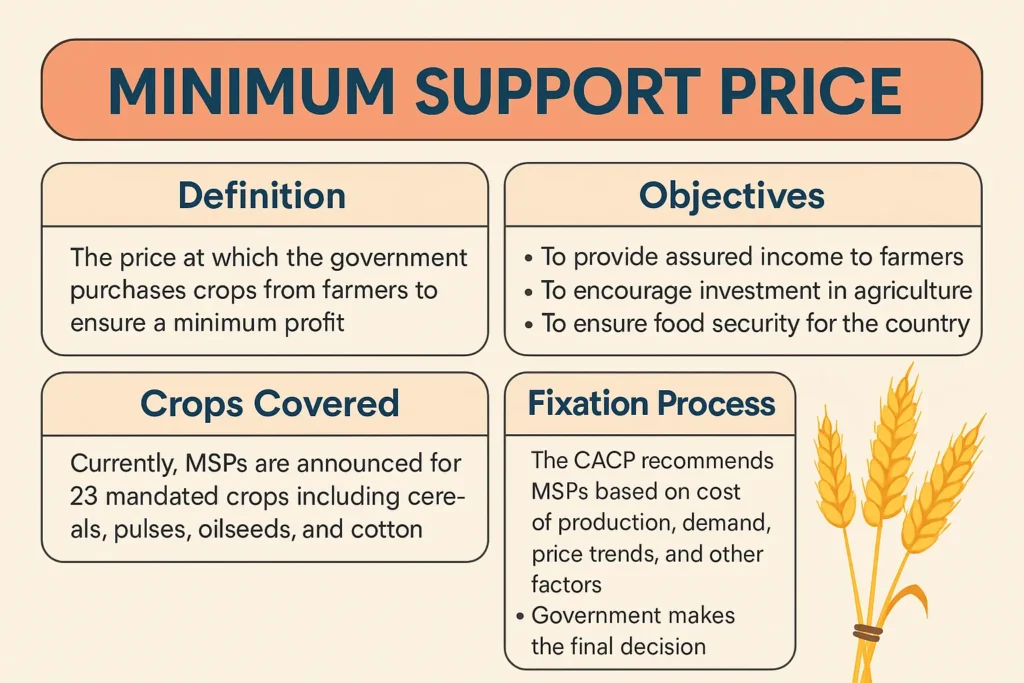Minimum Support Price (MSP)
Table of Contents
The Minimum Support Price (MSP) is one of the most important topics in the Indian Economy and Agriculture section of competitive exams like UPSC, APPSC, SSC, and banking exams. Every aspirant should understand what MSP is, how it is decided, why it is important, and the challenges associated with it.
What is Minimum Support Price (MSP)?
- Definition: MSP is the minimum price at which the government promises to purchase crops from farmers, even if market prices fall below this level.
- It acts as a safety net for farmers, ensuring they do not suffer from distress sales.
- Example: If MSP of wheat = ₹2,275/quintal, and market price = ₹2,000, the government will still buy at ₹2,275.
👉 “MSP is the minimum guaranteed price at which the government buys crops from farmers to protect them from losses due to low market prices.”
Objectives of MSP
- Protect farmers from price fluctuations.
- Ensure fair income for farmers.
- Encourage farmers to grow food grains for national food security.
- Promote crop diversification (to some extent).
- Support government buffer stocks & PDS (Public Distribution System).
Who Decides Minimum Support Price?
- MSP is decided by the Government of India on the recommendations of the Commission for Agricultural Costs and Prices (CACP).
- Final approval: Cabinet Committee on Economic Affairs (CCEA).
How is Minimum Support Price Calculated?
CACP considers the following factors:
- Cost of Production (CoP) → Different formulas:
- A2: Actual paid-out cost (seeds, fertilizers, hired labour, etc.)
- A2 + FL: (FL means Imputed value of family labour)
- C2: A2 + FL + Rental value of land + Interest on capital assets
- Government generally fixes MSP at 1.5 × A2+FL cost.
- Demand and Supply situation
- Market Price trends
- International Price comparisons
- Terms of trade between agriculture and non-agriculture
- Inter-crop parity (so that farmers don’t grow only one crop).
Crops Covered under MSP
As of now, MSP is announced for 23 crops:
Food grains
- Paddy (Rice)
- Wheat
- Maize
- Barley
- Ragi, Jowar, Bajra
Pulses
- Gram (Chana)
- Arhar (Tur)
- Moong
- Urad
- Lentil (Masoor)
Oil Seeds
- Groundnut
- Soyabean
- Sunflower seed
- Rapeseed & Mustard
- Sesamum
- Niger seed
Commercial Crops
- Cotton
- Jute
- Sugarcane (Fair and Remunerative Price – FRP)
- Copra
History of MSP in India
- MSP was introduced in 1966-67 during the Green Revolution to encourage farmers to grow wheat and rice.
- Initially, only wheat had MSP. Gradually, more crops were added.
- Sugarcane has FRP (Fair and Remunerative Price) instead of MSP, fixed under the Sugarcane Control Order, 1966.
Procurement under MSP
- Procurement mainly done by:
- Food Corporation of India (FCI) → wheat & rice
- NAFED → pulses, oilseeds
- Cotton Corporation of India (CCI) → cotton
- Procurement is effective only for wheat & paddy. For most other crops, farmers are forced to sell at lower prices due to weak procurement.
Recent Updates (Exam-Oriented)
- Budget 2018-19: MSP fixed at 1.5 times cost of production (A2+FL).
- Minimum Support Prices for Rabi Season 2026-27 announced on 01 October 2025 (important for exams):
- Wheat: ₹2585/quintal
- Barley: ₹2150/quintal
- Gram: ₹5875/quintal
- Lentil: ₹7000/quintal
- Rapeseed & Mustard : ₹6200/quintal
- Safflower: ₹6540/quintal
(Exact numbers vary each year, but aspirants must remember the principle: 1.5 × A2+FL)
Advantages of MSP
- Protects farmers from price crash.
- Assures food security for India.
- Boosts agriculture production during crises.
- Encourages wheat & rice production → Green Revolution success.
- Stabilizes rural economy.
Challenges of MSP
- Ineffective implementation – Only wheat & rice farmers benefit.
- Regional imbalance – Punjab & Haryana farmers get more procurement, while Eastern states benefit less.
- Crop distortion – Over-dependence on rice & wheat, ignoring pulses & oilseeds.
- Storage problem – FCI godowns often overflow.
- Environmental issues – Overproduction of rice & wheat causes groundwater depletion & stubble burning.
- Fiscal burden – High procurement cost for government.
Exam Pointers for Quick Revision
- Introduced: 1966-67
- Decided by: CACP → Approved by CCEA
- Crops covered: 23
- Sugarcane: FRP, not MSP
- Formula: 1.5 × A2+FL (since 2018-19)
- Effective only in: Wheat & Paddy procurement
FAQs on Minimum Support Price (MSP)
-
What is meant by minimum support price?
MSP is the guaranteed minimum price the government pays farmers for their crops, to prevent losses from price crashes.
-
Who decides MSP?
The CACP recommends, and the Cabinet Committee on Economic Affairs (CCEA) approves.
-
How many crops are covered under MSP?
23 crops, including cereals, pulses, oilseeds, and commercial crops.
-
What is the difference between MSP and FRP?
MSP applies to foodgrains, pulses, oilseeds, etc. FRP applies only to sugarcane, ensuring fair returns to farmers and is legally binding.
-
Why is MSP controversial?
Because procurement benefits mainly rice & wheat farmers in a few states, while most farmers don’t get real MSP support.
The Minimum Support Price (MSP) is one of India’s most important agricultural policies. It provides income security to farmers and ensures food security for the nation. However, its implementation challenges, regional imbalance, and environmental impacts need reforms. For exams, remember definition, objectives, calculation method (A2+FL), crops covered, and limitations.


